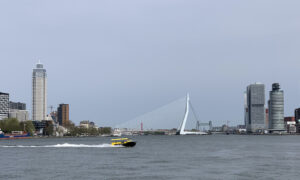I’ve worked in at least 40 countries around the world, and if I’ve learned anything, it’s this: Corruption is a corrosive nation killer.
When we went country shopping last year for Dispatches Europe’s headquarters, government transparency, stability and business culture were at the top of our list of national qualities we required, part of the reason we landed in the Netherlands. So, how transparent is Holland, judged against the other countries in the world?
Berlin-based Transparency International has the answer to that with their just-released Corruption Perceptions Index 2015.
No surprise … the Netherlands is among the highest-integrity countries, with an index score of 87. But to be clear, No. 1 Denmark, with the world’s highest score of 97, still comes up a little short in the 100-point rankings, meaning there is some room for improvement. There is no such thing as a country with a corruption-free public sector, according to Transparency International.
Other nations in Europe placing in the Top 10 are:
No. 2 Finland
No. 3 Sweden
No. 5 (tie) Netherlands and Norway
No. 7 Switzerland
No. 10 (tie) Germany and Luxembourg
Somalia and North Korea are tied for most corrupt at No 165. As Transparency International officials note, there are far more corrupt regimes on Earth than countries operating with high integrity. Sixty-eight per cent of countries worldwide have a serious corruption problem including half of the G20, the 20 largest economies, according to the Corruption Perceptions Index.
With transparency comes progress and affluence. Transparency International points out that five of the 10 most corrupt countries also rank among the 10 least peaceful places in the world.
That, and corruption ensures poverty, discrimination and income disparity.
While the Corruption Perception Index celebrates top-ranked European countries as bastions of probity, it also takes one of them to task for contributing to corruption in the Developing World, the report notes.
Take Sweden for instance. It comes third in the index, yet the Swedish-Finnish firm TeliaSonera – 37 per cent owned by the Swedish state – is facing allegations that it paid millions of dollars in bribes to secure business in Uzbekistan, which comes in at 153rd in the index. The company is now pulling out of business in Central Asia, but Sweden isn’t the only “clean” country to be linked to dodgy behaviour overseas. As our research shows, half of all OECD countries are violating their international obligations to crack down on bribery by their companies abroad.
The report notes several countries have improved since 2012 including Greece, Senegal and the UK. Others, including Australia, Brazil, Libya, Spain and Turkey, have become more corrupt. In fact, Spain is seriously on the naughty list at No. 36, sandwiched between Slovenia and the Czech Republic. Spain aside, Europe tends to become more corrupt the farther east you travel into the former Soviet Bloc states, at least by the Transparency International rankings. Albania, Bulgaria, Bosnia and Croatia are ranked below Turkey. The UN protectorate of Kosovo – once part of the Republic of Yugoslavia – is the lowest ranked European country, or whatever it is. (For this, we’re not counting Ukraine and Russia as part of Europe.) 
The CPI 2015 has lots of great data, graphs and illustrations. We especially enjoyed the little “Unmask the Corrupt” mini-profiles of the world’s most corrupt people, including Isabel Dos Santos, the daughter of Angola’s president. Dos Santos is the world’s youngest billionaire, according to Transparency International, in a country with the world’s highest rate of child mortality.
Top performers share key characteristics: high levels of press freedom; access to budget information so the public knows where money comes from and how it is spent; high levels of integrity among people in power; and judiciaries that don’t differentiate between rich and poor, and that are truly independent from other parts of government.
In addition to conflict and war, poor governance, weak public institutions like police and the judiciary, and a lack of independence in the media characterize the lowest ranked countries.
Here is the full methodology from the Transparency International website:
The Corruption Perceptions Index aggregates data from a number of different sources that provide perceptions of business people and country experts of the level of corruption in the public sector.
The following steps are followed to calculate the CPI:
- Select data sources: Each data source that is used to construct the Corruption Perceptions Index must fulfill the following criteria to qualify as a valid source:
- Quantifies perceptions of corruption in the public sector
- Be based on a reliable and valid methodology, which scores and ranks multiple countries on the same scale
- Performed by a credible institution and expected to be repeated regularly
- Allow for sufficient variation of scores to distinguish between countries
- The CPI 2015 is calculated using 12 different data sources from 11 different institutions that capture perceptions of corruption within the past two years. These sources are described in detail in the accompanying source description document.
- Standardise data sources to a scale of 0-100 where a 0 equals the highest level of perceived corruption and 100 equals the lowest level of perceived corruption. This is done by subtracting the mean of the data set and dividing by the standard deviation and results in z-scores, which are then adjusted to have a mean of approximately 45 and a standard deviation of approximately 20 so that the data set fits the CPI’s 0-100 scale. The mean and standard deviation are taken from the 2012 scores, so that the rescaled scores can be compared over time against the baseline year.
- Calculate the average: For a country or territory to be included in the CPI, a minimum of three sources must assess that country. A country’s CPI score is then calculated as the average of all standardised scores available for that country. Scores are rounded to whole numbers.
- Report a measure of uncertainty: The CPI is accompanied by a standard error and confidence interval associated with the score, which capture the variation in scores of the data sources available for that country/territory.
Co-CEO of Dispatches Europe. A former military reporter, I'm a serial expat who has lived in France, Turkey, Germany and the Netherlands.














